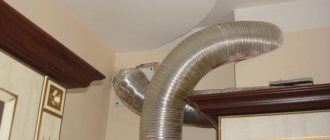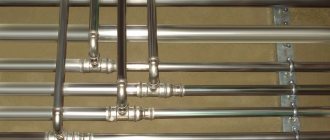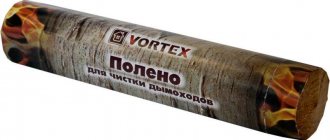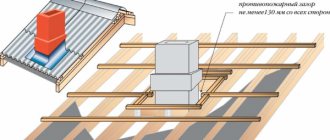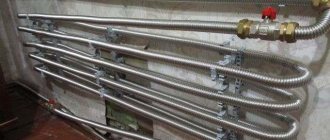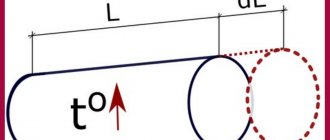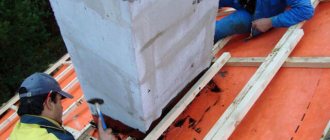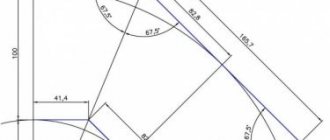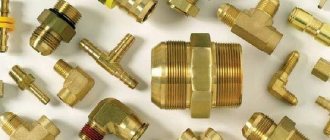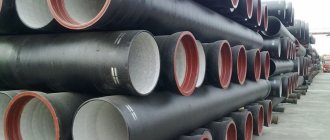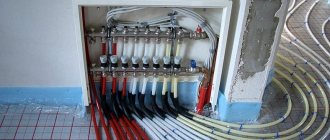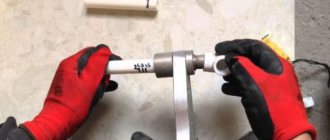Thanks to technological progress, many areas of the national economy have been able to make great strides forward. But, despite this, the question regarding the installation of stove heating is still relevant for many owners of suburban areas. This article will talk about the modern type of stainless steel chimneys and their constituent elements. You can read a review of stainless steel sandwich chimneys here.
The photo shows stainless steel chimney elements.
Rating of the best chimney manufacturers
| Photo | Name | Rating | Price | |
| #1 | CRAFT | ⭐ 100 / 100 36 — votes | Find out the price | |
| #2 | Volcano | ⭐ 99 / 100 16 — votes | Find out the price | |
| #3 | ROSST IN | ⭐ 97 / 100 3 - votes | Find out the price | |
| #4 | Jeremias | ⭐ 97 / 100 2 - votes | Find out the price | |
| #5 | Termofor | ⭐ 96 / 100 1 - voice | Find out the price | |
| #6 | Ferrum | ⭐ 96 / 100 10 — votes | Find out the price | |
| #7 | Elites | ⭐ 95 / 100 1 - voice | Find out the price | |
| #8 | Inzhkomcenter VVD | ⭐ 93 / 100 4 - votes | Find out the price | |
| #9 | Phoenix | ⭐ 92 / 100 5 — votes | Find out the price | |
| #10 | Baltvent | ⭐ 91 / 100 1 - voice | Find out the price | |
| #11 | Rosinox | ⭐ 90 / 100 | Find out the price |
Which chimney manufacturer would you choose or recommend?
Take the survey
Rating of chimney manufacturers: TOP 11 best
Before buying a chimney, a potential buyer should familiarize himself in advance with which brands currently offer the highest quality products.
Below we will talk about the best manufacturers, and also note their pros and cons. They have proven themselves well, which was also further confirmed in their reviews by the people who contacted them.
Rosinox
Rosinox
opens the ranking of the best chimney manufacturers with a brand that has been operating since 2001. Rosinox uses only high-quality stainless steel and other environmentally friendly materials, and all production is located in Klin. The best German technology is what helps a brand have a good product.
The best German machines are used for manufacturing, so products from Rosinox are quite competitive with the products of other companies presented below.
The dealer network is well developed, which means that the products of this domestic company can be found in almost any city.
All employees work extremely harmoniously, which allows you not to worry about the good operation of the chimney installed in your home from Rosinox.
The only disadvantage of this manufacturer is the problematic contact with the support service of this company.
pros
- Using fresh solutions and production technology from Germany.
- Dealer stores can be found everywhere.
- Use of environmentally friendly material.
- High quality products.
Minuses
- It is quite difficult to contact the support service of this company.
chimney Rosinox
Baltvent
Baltvent
This domestic company has been operating in the market of heating equipment and its components for many years. The production is located in Kaliningrad, and this city, which is important, is located near Europe. It was the location that influenced the technical base of the enterprise from the very beginning.
The best equipment from Europe, excellent specialists, high-quality materials - all this allowed us to become what we know it now - famous and with large production.
Quite important in this company is that the pricing policy of this company is within the average range with a high quality of the final product.
pros
- Modern European equipment with high production rates.
- Commitment to modern technological solutions that improve the product itself.
- The price of this company's products is within the normal range.
- Extremely high reliability of products from this company.
Minuses
- There is little that you can find interesting in the assortment of this company.
Phoenix
Phoenix
Another domestic company with production in the Moscow region, whose products are highly reliable and durable. A long warranty period will allow you not to worry about the condition of the chimney, because for this “Phoenix” uses not only high-quality materials, but also good equipment in combination with modern production technologies.
Before producing a chimney, the company creates a 3D model, on which everything is pre-checked, then plasma cutting and TIG welding. The result is obvious - a chimney of absolutely any shape and type with all the necessary certificates and documents confirming the high quality of the product.
Customers who contacted them were generally satisfied with the quality of service and product, noting only the average quality of the seam. Only a small number of people have developed a problem with corrosion on their chimney.
pros
- Chimneys are manufactured using the latest technologies.
- High-quality equipment from Europe.
- Long warranty period - 15 years.
- Installing a chimney from this company will be quite easy.
Minuses
- The chimney of this product is easily subject to corrosion.
- Not very good seam quality.
Sandwich bend 230x130
Inzhkomcenter VVD
Inzhkomcenter VVD
Another Russian company, founded in 1999 and known for the production and development of high-quality steel chimneys. Our own production allows us to achieve high quality and low cost products.
The versatility of the chimneys from this company allows them to be used in almost any heating system, which is extremely convenient.
It should be noted that people speak only positively about this company, highlighting the reliability and ease of installation of their chimneys.
pros
- Anyone can buy the product of this company due to its affordable price.
- High quality products.
- Installation of such a chimney will take place quite quickly.
- Extremely reliable chimney.
Minuses
- After some time, the chimney pipe may darken.
Elites
Elits
This company, judging by the name, makes only high-quality chimneys. And this is true, because all the efforts of specialists and engineers are aimed at one thing - creating high-quality and at the same time inexpensive products.
The use of high-quality material in the form of stainless steel allows us to achieve a long service life of the product - more than ten years without a single complaint.
Chimneys from Elits can be found in many summer cottages, private homes and even industrial warehouses. In addition, it should be noted the versatility of this company’s products.
Ease of installation, high-quality welding and appearance - Elits chimneys have all this. And as the name suggests, the pipes are truly of the best quality.
The only thing that people notice is the presence of minor flaws in the design, which are easily corrected.
pros
- Acceptable pricing policy.
- Easy installation.
- High quality seams.
- Wide range of use.
Minuses
- Design flaws.
Ferrum
Ferrum
In sixth place is the domestic manufacturer Ferrum, the range of which is quite large. Everyone can find the chimney that suits their home best.
All chimneys are manufactured in Voronezh, where the main workshop is located. Typically, the company uses high-quality raw materials that undergo a series of tests before entering the production and becoming a chimney. High-quality material is precisely what gives the company’s products the durability that the company has long been proud of.
Customers have repeatedly noted that the quality of Ferrum products is at the highest level, although the price, in their opinion, is very high.
pros
- Use of high quality metal.
- Availability of a large assortment.
- Possibility of purchasing individual components in a large range.
- Simple and convenient installation.
- Beautiful appearance.
Minuses
- High price.
chimney Ferrum
Termofor
Termofor
The top five of this rating of manufacturers is a relatively new company, founded in 2003. The brand developed so rapidly at the beginning that within a year it already had an award.
The company’s assortment includes a variety of products, among which you can find the following products:
- tanks;
- boilers;
- ovens;
- chimneys.
It should be noted the qualifications of our specialists, as well as powerful modern equipment that allows us to create a high-quality product.
True, it is important to be careful - Termofor has many fakes, the quality of which is too far from that of the original products.
pros
- Equipment and technologies are all the most modern.
- Qualified workers, thanks to whom the products are of such high quality.
- A large assortment.
- High quality product.
Minuses
- Counterfeits are common.
- Finding products from Termofor is not always easy.
Jeremias
Jeremias
The fourth place is occupied by this premium brand from Germany. The Bavarian company is the only foreign representative of this rating, so Jeremias will be quite interesting to look at.
The company itself was founded quite a long time ago - in 1970, but the company appeared on the territory of the Russian Federation not so long ago - in 2008, when the company opened its own representative office.
To put it briefly, the products of this company are characterized by several characteristic features:
- beautiful chimney design;
- straight seam;
- a combination of modern developments and high-quality raw materials.
Judging by the reviews, the chimneys of this company are installed quite easily, which is good news. In addition, high reliability and high-quality work of specialists stand out.
pros
- Excellent quality of everything - material, assembly and even seams.
- High-tech production of chimneys.
- Bright, attractive product design.
- High durability.
Minuses
- The price is biting.
chimney Jeremias
ROSST IN
ROSST IN
“Bronze” in our rating goes to a company whose production is located in Moscow itself. It has long been known in the market of heating equipment and their components, and there is no doubt about the quality of the products.
The chimneys of this company are considered quite universal, because they can be installed almost anywhere and without any problems.
Rosst In products are manufactured using the latest developments and using modern technologies.
High quality and reliability are what made this company one of the market leaders. The high price is the price to pay for the fact that chimneys will serve for a long time and with high quality.
pros
- High durability of this company's products.
- From a design point of view, the chimneys of this company look quite neat and fresh.
- Using modern technologies and only high-quality materials.
Minuses
- High price.
Volcano
Vulcan
The company that took second place in this rating began producing chimneys back in 1996. Therefore, we can say that there is a very rich assortment of chimneys from this brand.
Any potential buyer, whether he is a private owner or a representative of another company with his own production workshop, can find a chimney model suitable for him from this company.
Qualified specialists are constantly introducing new technologies. Having our own laboratory allows us to quickly test new possible options in search of the best solution.
High-quality materials and raw materials, as well as the most modern technology, are what the company uses to create its famous chimneys, which are quite capable of competing with their competitors, since such serious companies as Nissan and Toyota pay attention to them, which is extremely significant.
Vulcan products have all the necessary certificates and licenses, which confirm the high quality of the products, as well as a long warranty period, with which you can forget about the issue of replacing the chimney for a long time.
pros
- Advanced production with modern technologies.
- A very long warranty period of fifty years.
- Use of high quality raw materials in production.
- Availability of our own laboratory for testing.
Minuses
- High price.
chimney Vulcan
CRAFT
CRAFT
“Gold” goes to a fairly young domestic company, which at the same time has quite high-quality products for the heating systems market.
It is interesting that the products of this company do not go outside the country, which means they are sold only for the domestic market, which allows us to talk about an adequate price for most buyers.
The use of high quality materials, as well as an emphasis on modern equipment and technology, allows us to achieve the best products that will delight you with reliability and durability.
pros
- Use of very high quality materials.
- Using the best technological base.
- Modern equipment.
- Reliability of goods.
Minuses
- Not detected.
chimney Craft
Stainless steel grade
Before you start making a chimney, you need to find the material. In this case, it will be stainless steel. Interestingly, it can be completely different, although its types will not differ too much from each other.
The main differences they will have are their composition, which will determine their resistance to high temperatures and acid. The higher it is, the longer the material will remain in its original state.
Today, manufacturers use only one series - the three hundredth, which is an example of quality. Here we will look at it below using the example of several representatives of this series.
The brand can decide a lot in the production of a chimney
AISI-304
- Austenitic stainless steel. It is an admixture of steel, chromium (18-20%), nickel (8-12%) and carbon (up to 0.08%).
- Steel with high resistance to acid and high temperatures (up to 400 ℃ taking into account the average acidity level of the environment), therefore it is recommended for gas and solid fuel boilers.
Important! Very widely used in food production.
AISI-316
- The composition is the same as AISI-304, but in addition molybdenum is added (2-3%).
- Even greater resistance to negative external effects (up to 750 ℃ without deformation).
A chimney made of such material can be used in almost any type of boiler, and it does not matter what the heat source is.
AISI-309, AISI-321
- Refractory stainless steel. It is an admixture of steel, chromium (19-21%), nickel (11-13%) and carbon (up to 0.2%).
- High resistance to high temperatures (up to 1050 ℃) as well as acid.
This material is used to produce chimneys that will work in places with the most difficult conditions.
- Bathhouse.
- Sauna.
- Solid fuel boiler.
Each brand has its own properties suitable for a particular task.
Properties of stainless steel
The performance characteristics of chimneys directly depend on what grade of material was used in their manufacture. In this regard, when purchasing pipes, you need to pay attention to the markings:
- 409 is a steel suitable for heating devices that operate on solid fuel.
- 430 - used mainly for parts that are practically not exposed to aggressive influences. Typically, the outer part of the casing is made from such steel, since it does not deform in a humid atmosphere.
- 316 is a material containing elements such as nickel and molybdenum, which provides acceptable resistance to thermal and chemical influences. This circumstance allows us to say that such pipes are ideal for a gas boiler.
- 304 is a steel whose characteristics are comparable to grade 316, but with a significant reduction in the amount of alloying additives, which ultimately reduces the cost of the finished product.
- 316Ti and 321 are multifunctional steel grades with excellent ductility and resistance to aggressive environments, capable of withstanding temperatures up to 850 °C.
- 310S is a first-class steel that has many positive characteristics, including resistance to temperatures up to 1000 °C.
Type of heating equipment and chimney: what you need to know
When installing a stainless steel chimney, it is necessary to take into account not only the material itself and its brand, but also the thickness of the chimney wall. But, in addition to this, you need to take into account what equipment is at home.
Below is an example of what heating equipment is available and what requirements it may have:
- stove or fireplace - AISI 321 (wall thickness - 0.5-1.0 mm);
- diesel boiler - AISI 316L (wall thickness - 0.5 mm);
- gas boiler - AISI 304(L) and 321 (wall thickness - 0.5 mm);
- solid fuel boiler - AISI 309, 310 and 321 (wall thickness - 1.0 mm).
Conclusion No. 1: solid fuel boilers need to have a chimney with a wall thickness of 1 mm. This chimney is made of heat-resistant steel, since the temperature inside the pipe can reach 500-700°C.
Conclusion No. 2: liquid fuel and gas boilers emit acid, which means that you need to install a chimney with high resistance to temperature and acid, with a wall thickness of 0.5 mm.
| Heating installation | Temperature inside the active installation, °C | Stainless steel grade, AISI | Wall thickness of the inner pipe, mm | Thickness of the thermal insulation layer, mm |
| Fireplace, stove | 350 — 650 | 321 | 0.5 – 1.0 | 50-100 |
| Sauna stove | 400 — 700 | 321 | 0.8 – 1.0 | 100 |
| A gas boiler | 120 — 200 | 304, 304L, 321 | 0.5 | 30-50 |
| Diesel boiler | 150 — 250 | 316L | 0.5 | 30-50 |
| Solid fuel boiler | 500 — 700 | 309, 310, 321 | 1.0 | 100 |
| Gas piston and gas turbine units | 450 — 600 | 316Ti, 321 | 1.0 – 1.5 | 100 |
| Diesel generators | 450 — 600 | 316Ti | 1.0 – 1.5 | 100 |
Advantages and disadvantages
Stainless steel chimney pipes meet the requirements for the safety and reliability of the channels used to remove combustion products, which allows us to talk about the following advantages:
- the surface of the chimneys retains in the form of precipitation a small amount of products of the chemical reaction of oxidation of the substance;
- unlike ceramic systems, the chimneys in question do not require a special foundation for their installation;
- high resistance to acid attack as a result of fuel combustion;
- due to the modular type of chimneys, their installation is simplified as much as possible;
- sandwich systems virtually eliminate the possibility of a fire;
- high level of tightness.
Regarding the disadvantages of stainless steel-based chimney systems, the following can be said:
- the use of structures where single-wall pipes are used as vertical channels can cause fires due to strong heating of the walls of the product, so it is advisable to insulate them;
- Sandwich systems are more reliable, but even here there is a drawback such as deformation of the weld due to temperature changes, when the metal periodically contracts and expands, which reduces the tightness of the welded joints.
Range
Installing a stainless steel chimney is a rather difficult task, and therefore many people need to use a solution that is ready for installation. Many models include various parts of the pipe, so it is quite possible to install the structure yourself.
Let's consider all these elements.
- Straight pipes. Their length, as a rule, is from 33 to 100 cm. The bell joint is what firmly connects the pipe elements to each other.
The pipe does not require additional fasteners - Bends at an angle of 45°. They are best used when there is a need to deviate from the vertical.
- Bends at an angle of 90°. Thanks to them, it is possible to make transitions between the vertical and horizontal sections of the place where the pipes are laid.
Bends at 45 and 90 degrees - Condensate collector. It is placed at the lowest point of a vertically running pipe. It is used to collect water that appears when smoke cools.
- Tee at 45° and 87°. With it you can assemble pipes where you plan to collect condensate. In addition, such a tee is useful when connecting two heating devices connected to a common chimney.
- Revision element. The inspection is placed where soot is most likely to accumulate. Its use is to check and clean the chimney.
Chimney inspection - Penetrations. This element provides insulation of the structure for fire protection, sealing the roof, and also guarantees an improvement in the design of the pipes.
- Additional accessories. To protect against precipitation inside the chimney structure, against back draft and against sparks, a number of accessories are installed on the roof, including a cap and a spark arrestor.
Chimney cap
Stages of installation of the structure
To save money, you can install a chimney yourself - we’ll figure out how.
- A metal pipe of a certain height is installed at the outlet of the smoke collector, since the heat transfer into the room from the heating equipment depends on it. It is necessary to install the structure “along the smoke”. After installing the pipe, you need to put it on the pipe and install a gate that will block the channel. All joints are carefully coated with a special heat-resistant sealant.
- After installing the main part of the structure, you need to put on a starting sandwich chimney in the form of a double pipe, which is closed on one side. This sandwich will then be covered with all the necessary products. And yes, the joints are again connected with a special sealant.
- Now you can collect all the elements. Everything is installed so that the condensate flows to the desired point. All joints must be treated with sealant.
It is important not to forget to treat all connections with sealant - Installing pipes on the roof involves the use of an unloading platform, and just below you can use special clamps. They should be used where parts of pipes are connected, because this way you can increase the strength of the entire structure. Highly flammable materials are insulated with a layer of basalt wool in a box.
- All pipelines with tortuosity and branches must have inspections so that the pipes can be cleaned without problems.
- The last stage - the apron and conical roof are installed along with the deflector or cap.
Following the steps will allow you to install the pipes so that they function correctly in the future
Installation
As I already said, assembling the chimney is very simple. BUT. If you don’t understand much about this matter, entrust the work to a specialist, since, in addition to heat, fuel (during the combustion process) releases a huge amount of substances harmful to human health.
1.) Preparation. The process consists of the following steps:
- calculation of the chimney configuration;
- sketching and marking walls;
- purchasing the required amount of materials.
2.) Processing. The process consists of the following steps:
- carefully applying sealant to the seams inside the chimney;
- It is not necessary to apply sealant to the seams on the outside of the chimney as it will fall off.
3.) Installation. The main workflow consists of the following steps:
- assembly of chimney pipe links sequentially: each subsequent pipe is inserted into the previous one;
- pipes are placed on top of each other to a depth of at least half the outer diameter of the pipe;
- laying working channels along the wall;
- fixing working pipe joints with clamps;
- fastening pipes to load-bearing structures with brackets at a distance of 1–2 m.
4.) Insulation of pipes (possibly with fiberglass). Of course - if the sandwich is a chimney, then you don’t need to do anything.
5.) Waterproofing of pipes in areas adjacent to roofing materials. For the sandwich, a special cuff is very convenient - master flash, and of course, heat-resistant sealant.
As you can see, there is nothing complicated, but do not underestimate this process in order to avoid disastrous consequences.
Care and maintenance of a stainless steel chimney
For more efficient operation of a stainless steel chimney, you need to follow the recommendations below.
- Before lighting a boiler or stove for the first time, you need to check in advance whether there are any foreign objects or debris in the smoke duct. If there is one, then you need to take some long tool and push it all the way to the revision. When the debris is there, you need to open the inspection channel, pull it out of the pipe, and after getting rid of the debris, the chimney and inspection channels are cleaned of soot with a brush.
- Do not throw household waste into a working stove or boiler for combustion, as it can worsen the condition of the chimney.
- As a rule, coniferous logs are not used in solid fuel heat generators. The reason is the resin content, which will quickly accumulate. The only exception is aspen logs, which can create a high fire and burn off soot in the chimney.
Several rules must be followed for the correct operation of the chimney.
From time to time it is necessary to inspect the roof on the roof if it is made of metal. This is done to detect any rust that may have appeared on the outside of the pipe. Yes, it can even hit stainless steel, which is quite unusual.
What should you do if you find such a problem?
- Clear the area around the pipe.
- Remove the problematic piece of pipe.
- Clean, sand and degrease the work surface.
- Holes and cracks should be sealed thoroughly.
- Rinse with hot water and then dry thoroughly.
- Fill all the cracks found with a special sealant.
- Take a silicone nozzle, put it on the pipe, and secure it with self-tapping screws for greater strength.
Mistakes made when arranging the chimney will lead to the reappearance of rust on the pipe or its transfer to the roof.
The roof should not rust if everything is done correctly.
You may be interested in finding out which sauna stoves are worth buying.
Stainless steel instead of ceramics: in which case is it better to choose steel?
Everyone knows that the chimney is an important part of the heating device. And this means that his choice must be correct. And for this you need to know when and where it is best to use it. Quite a long time ago, the ceramic option was popular, and it could be found literally everywhere, but today it would be out of place, and therefore stainless steel, as an alternative, would look quite good.
Below, experts from Obzor-Expert.com have identified the three best cases when it would be perfect.
- Boilers with a closed combustion chamber. It is better to use steel pipes for them. They are much more convenient than ceramic ones in terms of installation.
- Modernization of a brick stove or fireplace. This is easier if you add stainless steel elements.
- Installation of an additional chimney. This is best done using double-layer sandwich pipes.
Important! It is quite difficult to choose the ideal option for heating equipment. Both options - ceramic and stainless steel - have their own characteristics, pros and cons, and therefore you need to study everything carefully before choosing one.
An excellent alternative to stainless chimneys
Despite the fact that metal chimneys are made of stainless steel, they quickly collapse under the influence of condensation. The reason for this is the content of acidic compounds in the condensate. The walls of the pipes burn out in just 7-10 years, and the chimney needs to be replaced.
To solve the problem for a long time, you should use FuranFlex polymer pipes. The material is resistant to corrosion and does not rot during operation, since it is made of polymers.
Installation of FuranFlex is carried out in a few hours without dust and dirt, since dismantling work is not required. The inside of the pipes has a smooth surface, which improves traction. In addition, the composite material has low thermal conductivity, so the amount of condensation is significantly reduced. You can learn more about the technology from our specialists.
Stainless steel pipe options
Today you can find as many as three options for this type of chimney.
- Single-walled (thickness – 0.6-20 millimeters).
- Corrugated.
- Three-layer sandwiches (two pipes + insulation).
Let's consider each of the options, taking into account their pros and cons in the form of a table.
| Pipe type | Advantages | Flaws |
| Single layer | Low cost, smooth inner surface. | High heat transfer rates, condensation may form, the need to install thermal insulation. |
| Corrugated | Elasticity, some flexibility. | Low resistance to high temperatures, rapid wear, corrugated inner surface on which condensation can accumulate, not suitable for horizontal sections of the chimney duct, it is necessary to fix it, and also install thermal insulation. |
| Three-layer | Low heat transfer rates, versatility, easy assembly, tight joints. | The cost of this type of pipe is quite high compared to others. |
Each type of pipe has its own characteristics that hinder or help in choosing
Extremely important! Regulatory authorities, upon seeing corrugated pipes, will most likely refuse to supply gas.
Video - About choosing and purchasing a stainless steel chimney
What is the difference between AISI 304 and 430 stainless steels?
Information article
There are many different models on the sauna stove market that use stainless steel, but not all stainless steel is equally good. Let's try to figure out how stainless steels differ from each other. Let's take as an example the most common steels AISI 430 (17X18 according to GOST) and AISI 304 (12X18H10 according to GOST).
Many manufacturers of sauna stoves use AISI 430 steel in their production, since according to the heat resistance table it is higher. The use of this steel is also justified by its relatively low price compared to AISI 304 steel. AISI 304 steel has slightly less heat resistance compared to AISI 430, but this is its only minor difference. Since there are more important indicators that directly affect the performance and durability of the product.
First, let's find out in more detail what kind of steel it is.
Stainless heat-resistant (austenitic) steel AISI 304 (INOX)
Heat resistance
is the ability of a metal to resist plastic deformation and fracture at high temperatures.
The main heat-resistant austenitic steels are chromium-nickel steels. Steels contain 15...20% chromium and 10...20% nickel. They have heat resistance and heat resistance, are plastic, and weld well.
Steel grade AISI 304 (INOX) - belongs to the chromium-nickel class of low-carbon high-alloy steels. High chromium and nickel content
determines excellent strength and anti-corrosion properties, which are in demand everywhere - they are defined as universal. That is why this alloy is one of the most used.
In the GOST system, this grade corresponds to 12X18H10 steel.
The main qualities that give advantages to AISI 304 are: resistance to oxidation and elevated temperatures, increased reliability of welds due to good weldability.
AISI 304 has the following performance properties:
- Acid resistance.
Resistance to aggressive influences of a man-made or natural nature. - Heat resistance.
The ability of a metal to resist plastic deformation and fracture at high temperatures. - Heat resistance.
The ability of metals and alloys to resist gas corrosion at high temperatures for a long time (up to 850oC). - Weak magnetic properties.
They are achieved due to the structure of the material and the method of its processing.
AISI 304 steel is not magnetic. - Environmentally friendly.
Manufacturers of AISI 304 position this material, also called Inox, as food grade stainless steel. It does not contain toxic substances.
Stainless heat-resistant (ferritic) steel AISI 430
Heat resistance (scale resistance)
is the ability of metals and alloys to resist gas corrosion at high temperatures for a long time.
If the product operates in an oxidizing gas environment at a temperature of 500..550 oC without heavy loads, then it is enough that they are only heat-resistant (for example, individual parts of heating furnaces). Being low-alloy and corrosion-resistant, AISI 430 steel has good resistance to scale formation up to temperatures of 850-900
o C
, maintaining its useful performance properties.
To increase heat resistance, elements are introduced into the steel that form oxides with a dense crystal lattice structure (chromium, silicon, aluminum) with oxygen.
In the GOST system, this grade corresponds to steel 17Х18.
AISI 430 has the following performance properties:
- Heat resistance.
The ability of metals and alloys to resist gas corrosion at high temperatures for a long time (up to 900oC). - Environmentally friendly.
It does not contain toxic substances.
Comparison of AISI 304 and 430 stainless steels
AISI 430 steel, although more heat resistant, is more brittle and difficult to weld. In order to weld it efficiently, a special complex technology and its exact observance at all stages of work are required. This steel is mainly used for decorative purposes. Welded structures made from it are very fragile and the weakest point will always be the welding seam.
This AISI 430 steel has lower acid resistance compared to 304 stainless steel, and when working in harsh conditions of water, soot and condensate, it gradually becomes unusable, so, for example, chimney pipes made of such steel still burn out. They are simply corroded by the acid produced as a result of the operation of the furnace. Also, AISI 430 steel is magnetic, which easily gives it away during any magnetic test. This way you can easily determine which stainless steel is in front of you - AISI 430 or real non-magnetic stainless steel AISI 304.
AISI 304 (INOX) steel is a heat-resistant steel and is not afraid of high temperatures when operating a sauna stove. It is perfectly weldable due to the higher quality steel composition and high nickel content. Nickel is a very expensive metal, but with its high content in stainless steel, it acquires increased strength and resistance to temperature changes, and also acquires excellent weldability. It is thanks to nickel that this steel loses its magnetic properties.
Also, AISI 304 stainless steel is resistant to chemical and acid influences and does not emit harmful or toxic substances. Therefore, this steel is mainly used in the food and medical industries and is classified as food grade stainless steel.
Features of operation
A stainless steel chimney is quite popular today, but, like other chimneys, it needs to be checked from time to time and generally taken care of. Below we will talk about how to do it correctly.
- The first thing to do when using a steel chimney is to carefully inspect the heating apparatus before each season. From time to time it may need to be cleaned to remove soot and other dirt.
- Next, you need to check the draft when the time comes for the first ignition. If it’s not there, then you need to find out what’s wrong. As a rule, simply warming up with improvised means and then checking the traction with a match is enough.
Important! The draft is checked with the regulator valve or gate open.
- You need to inspect the chimney duct to see if it is clogged with soot. You can get rid of it using a soft stainless steel brush and a plaque softener.
- From time to time you can add aspen firewood, which can be used to remove soot from the chimney.
- Proper use of the stove involves the use of resin-free wood from deciduous trees. It should also be noted that it is impossible to use cuttings of plywood and chipboard for ignition.
It is necessary to take into account the presence of a number of operating features that determine the service life of the chimney
You might be interested in knowing which air conditioners are worth purchasing.
Installation methods
There are two ways to position the chimney, based on the location of the heating device in the house.
- Outside the house . The simplest and therefore popular chimney installation technology. To successfully implement the idea, a double-circuit chimney with fastening in the form of clamps is used. To prevent heat loss, thermally insulated pipes are used.
- Indoors . A more complex and expensive option, which requires taking into account the design of the room, because the chimney will go through the interfloor ceilings and the roof to the outside, that is, to the street. The difficulty lies in the requirement to insulate the chimney pipe, especially at the point of contact with the roof, where spark arresters are installed. However, the advantage of such a system is to reduce heating costs.
There are two different installation methods, each with its own advantages.
Types of pipes
Stainless steel is used to make three types of chimney pipes, each of which has its own specific application. It is important to take this into account when choosing an option for a residential building, bathhouse or other building. Manufacturers offer the following types of designs:
- single-walled (single-layer);
- corrugated;
- sandwich pipes.
Let's take a closer look at which stainless steel chimney pipe would be more appropriate for use in certain conditions.
Single wall pipes
Single-layer systems are made of stainless steel sheet with a thickness of 0.6 to 2 mm. The option is characterized by a low price, but the scope of application of such a pipe is limited.
It can only be installed inside a warm room, and the outer part of the chimney should be insulated. This is due to the fact that contact of heated metal with cold air leads to increased formation of condensation. This reduces the efficiency of the heating unit, entails excessive fuel consumption, and reduces the service life of the stove or boiler.
Single wall pipes
Single-wall steel pipes are most often used to arrange sleeves when modernizing brick smoke ducts. Lining extends the service life of a brick chimney due to protection from destructive condensation, and reduces the need for maintenance, since soot does not build up on the walls. Manufacturers offer single-layer stainless steel pipes of different sizes, round and oval sections, which allows you to choose the best option for a particular brick chimney.
A single-layer pipe can also be used in conjunction with a water heating system for a small room - a garage, workshop, washing department of a bathhouse. In this case, a water jacket is mounted on the chimney pipe, to which the supply and return pipes are connected. Also, the thermal energy of exhaust flue gases can be used to heat a compact room by running a single-layer pipe at an angle along a long wall.
Installation of a chimney made from a single-layer stainless steel pipe requires strict adherence to fire safety rules when arranging passages through the floors and roof. The ignition of soot in a pipe (especially when using a solid fuel stove) can heat the metal to critical temperatures and lead to the fire of wooden structures.
Corrugated pipes
The corrugated stainless steel pipe is designed for installation of curved transitions if the outlet pipe of the boiler or furnace is located away from the vertical chimney channel. Also, when lining a brick chimney, a corrugated pipe can be used inside a structure that has bends.
Corrugated pipes
It is necessary to choose a high-quality corrugated pipe made of stainless steel that can withstand heating up to 900 °C. Corrugated elements are used inside and outside the building, but in the second case they require insulation to avoid the formation of condensation due to contact of the metal with cold air.
Note! A chimney project using corrugated elements may be rejected by regulatory authorities, since there are complaints about the strength and heat resistance of corrugated pipes.
Sandwich systems
A two-layer pipe, which is a sandwich with a non-flammable heat insulator between metal shells made of stainless steel, is produced in the form of straight and shaped elements for assembling a chimney of any configuration. Due to the thermal insulation layer, this is the most practical option for a smoke exhaust duct, because:
- increased safety is ensured (the outer walls of the system do not heat up to dangerous temperatures, the heat insulator itself is resistant to ignition);
- allows you to install the chimney outside the building;
- a minimum of condensation is formed (the internal pipe through which combustion products move does not come into contact with cold air);
- there is no unnecessary heat loss, which allows the heating unit to operate in optimal mode, without excessive fuel consumption;
- the system is installed quickly and without the hassle of pipe insulation.
Sandwich systems
Sandwich pipes are universal; they are used for installation on gas or solid fuel boilers, fireplaces and stoves of any type.
Installation recommendations
The recommendations below will help you install the chimney correctly so that it functions without any difficulties.
- If you install a pipe with a height of five meters or higher, you can achieve good traction.
- The length of horizontal sections should be up to one meter, no more.
- Installing a chimney outdoors or in an unheated room requires the installation of thermal insulation material.
- If the chimney passes through a roof built with flammable materials, a spark arrestor must be installed.
If you strictly follow the proposed recommendations, you can install a chimney without any problems
Important! Joining uninsulated pipes in the wall is prohibited if the chimney ducts are not insulated.
We install a sandwich chimney
We have already said that you can connect the chimney yourself. To do this, you need to lead the pipe through the roof or directly into the wall, and then lift it up through the rotary channel. In order for the combustion in the stove to be better, first install a regular pipe, and then a sandwich chimney. An ordinary pipe emits strong heat radiation. The pipe temperature is not less than the combustion temperature. To reduce heat, the pipe is equipped with a brick mesh. Thus, after the end of combustion, the pipe heats the room for a long time, and the initial temperature is quite acceptable.
In some cases, water is heated through a chimney. Then a special tank is used, which is installed near the first pipe that comes from the furnace.
Assemble the sandwich panels in the direction of the smoke. If you look closely, each panel has a thicker end on one side and a thinner end on the other - for connection. So the thick end is always installed on top so that smoke does not enter the house. The joints must be sealed. A sealant is used for this. If this is not done, oxygen may get inside the chimney, which will ignite the soot.
To install a chimney, you need to make a hole in the wall or ceiling, depending on the method of installing the chimney. It is forbidden to immediately install a sandwich panel to the nozzle from the stove. A steel pipe is used as a connection. Otherwise, the sandwich chimney will quickly burn out. It is very important to correctly route the chimney through the ceiling. After all, most often fires occur in bathhouses due to improper installation.
The minimum distance from the chimney body to the ceiling must be at least 13 centimeters. If the walls are wooden - then 38 centimeters. Next you need to fix the pipe in the ceiling area. Sometimes a profile corner and self-tapping screws are used. To prevent water from the roof from entering the premises, a galvanized sheet is used, which is then sealed with silicone.
Voting: the best chimney manufacturers
Which chimney manufacturer would you choose or recommend?
CRAFT
45.57 % ( 36 )
Volcano
20.25 % ( 16 )
ROSST IN
3.80 % ( 3 )
Jeremias
2.53 % ( 2 )
Termofor
1.27 % ( 1 )
Ferrum
12.66 % ( 10 )
Elites
1.27 % ( 1 )
Inzhkomcenter VVD
5.06 % ( 4 )
Phoenix
6.33 % ( 5 )
Baltvent
1.27 % ( 1 )
